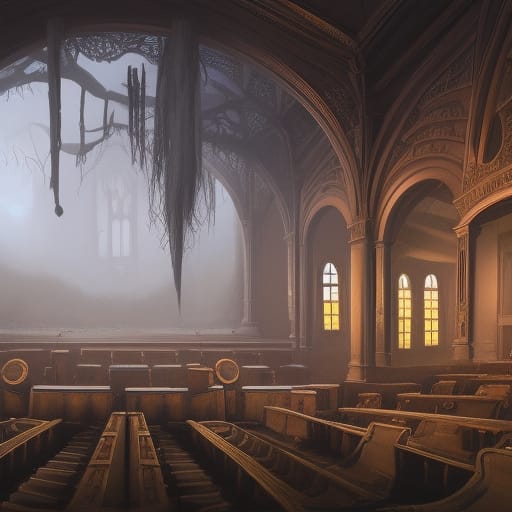
The Haunted Lecture Hall

A ghost story… (not really, it’s about higher ed)
As I mentioned in my last post, one of my favourite book genres is the haunted house. There are many variations on this, but at some point the authors of all such books face a dilemma – how do they keep the narrative moving towards the scary finale, when all sensible people would leave? This calls on a literary or plot device of some sort that keeps our protagonists in situ, while ratcheting up the horror. It can be that they simply are not allowed to leave (for example, the old escaping and after hours walking ending up back at the same place approach), they are bound to the property by some reason (financial, emotional), the need for an answer (some element in their past needs resolving), time running out (‘we’ll be picked up in 24 hours), isolation (cut off in a snowstorm in the forest) or that the haunting follows them wherever they go. Often though it is just lazily ignored or brushed over with excessive scepticism – sure the walls were bleeding last night but hey, that stuff doesn’t happen, let’s ignore it. Breakfast anyone?
These reasons for staying and seeing it out came to mind recently when I was reading various twitter threads and articles on the empty lecture halls that many educators are encountering. Not reduced numbers turning up, but absolutely no-one there. The Twitter thread from Peter Olusoga is very thoughtful and gives many possible reasons – fatigue, mental health, lecture capture, etc. It’s a thorny dilemma for universities – students, parents and government say they want face to face lectures, but then nobody is turning up for them. There’s a meta and a micro thing going on here I think – at the meta level everyone seems to agree that universities with lecturers giving lectures is what should be happening and is desirable. But at the day-to-day level students are making micro decisions about attendance – if the lecture capture is good enough, then maybe that commute to the uni, getting out of bed, or giving up extra time is not a worthwhile trade-off. Throw in to the mix that many students have to work or have care and support responsibilities and it seems entirely predictable and understandable not to attend.
It would be interesting to see data on time of lectures and timetabling effects. For instance are 9am lectures more severely affected, and does have a significant gap between two lectures on the same day have an impact? It might be worth going in if you have two lectures back to back. Also are certain disciplines or student demographics more affected? There is a tendency to still think of all students as full time 18-22 year olds with no other commitments, and that simply isn’t the case: Non-traditional students are now the majority.
Higher education is now at the plot device point in the haunted house story, where the essential question is – why stay? Like in fiction, one reason is the financial imperative to do so – just as our newlyweds have sunk their money into this old house and cannot afford to move simply because there is a portal to hell in the basement, so universities have been investing in lecture theatres and new buildings. And as with the ‘can’t escape’ option there is a lot of socio-cultural baggage also that keeps bringing everyone back to the same point. It’s what we know, it’s what people expect, it’s what our infrastructure and financing is built around.
I expect there are multiple responses to this (I’d be wary of anyone suggesting there is one simple answer). It may involve altering the nature of lectures to make attendance more worthwhile, implementing punishments for non-attendance (not a fan of this one), looking at timetabling from this perspective, providing increased support and flexibility for students, making the campus more attractive as a location, implementing hybrid options that swap online and face to face, etc.
Interestingly, as I was writing this list, it occurred to me how similar it was to the sort of responses we need to consider for assessment in the face of AI generated content. And that’s not surprising I guess, we are asking the same sort of questions in both instances – should we keep doing what we’ve been doing? If so, why? How do we adapt practice to recognise the new reality while still providing students with good education? And as with assessment, the options range from hardline retreating to established practice, for instance face to face exams, no lecture capture, insistence on face to face attendance, to more fundamental change, including no assessment or fully online. And there is everything inbetween. What I don’t think is valid is the equivalent of the lazy option in the haunted house, let’s pretend it hasn’t happened and carry on. I’ve read a lot of those books and seen a lot of those films, and I tell you, that never ends well.


One Comment
Pingback: